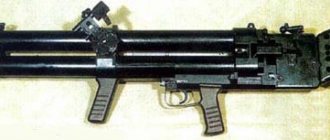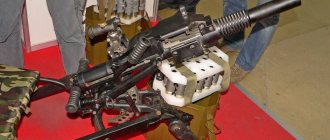XM-25 development history
In the late 80s of the twentieth century, a proposal arose in the US Army to create universal small arms, which would significantly increase the combat effectiveness of both an individual soldier and entire military formations of various sizes. The plans included arming 4 of the 9 soldiers in the rifle squad with weapons created under the OICW program. It was believed that replacing the standard M16A2 rifle with the M203 grenade launcher with a weapon of a new model gave an increase in the firepower of the platoon by up to five hundred percent, due to the possibility of suppressing individual enemy groups at distances exceeding aimed fire from assault rifles (800-1000 meters). In 2004, the main program for the development of the XM-29 was officially completed, the program itself was divided into two directions. The development of the new complex was carried out by the weapons company Heckler & Koch (development of the XM-8 assault rifle, and production of the XM-25) in collaboration with Alliant Techsystems, which was supposed to develop a new generation computerized ballistic module.
The XM25 individual semi-automatic directional detonation weapon was obtained by dividing the XM29 OICW assault complex into two independent modules - the XM-8 assault rifle and the XM-25 semi-automatic grenade launcher, in order to create a universal weapon for a limited unit. The purpose of this division was the large dimensions of the XM-29, its heavy weight and the need to use ammunition of limited destruction, subsequently developed for this weapon. The grenade launcher is equipped with an all-weather optical sight with an XM-104 ballistic computer, which displays data on shot adjustments to the eyepiece or fighter’s tablet. Also, the sighting module is equipped with a built-in thermal imager, allowing you to fire at any time of the day and in any weather.
XM-25 grenade launcher ammunition
The main direction of detonation of a programmable ammunition is airborne. In this case, the ammunition explodes directly above the target, hitting the enemy without protection. The radius of scattering of fragments is six meters. To do this, the operator needs to point the weapon at the target, the built-in computer, based on the readings of the laser rangefinder, determines the range, as well as the necessary corrections when firing. After this, the operator needs to select the detonation point and fire the shot. All keys for setting up the computerized module are located on the tactical handle, into which part of the safety bracket is turned.
The grenade launcher shows good effectiveness when firing at a dynamic enemy located in shallow trenches, or in buildings or premises, as well as in forest belts. At the same time, there is a high probability of an effective shot at distances of up to 500 meters, which is an unattainable distance for M203 grenade launchers or rifle grenades. When shooting at targets hidden indoors, PD or PPD modes are used - detonation mode on touch, or detonation mode on second touch. The first mode is used when it is possible to fire at a building in which there are no obstacles in the form of plywood panels or glass in the door and window openings. The second mode also allows you to “work” on targets hidden in cars - the contact detonator will work only after the second touch. There is also a rapid fire mode, which is used to conduct rapid fire at a suddenly detected enemy in urban areas or trenches. The essence of this mode is as follows: the operator aims at the enemy’s shelter, and then indicates the second point where the detonation occurs at some distance from the aiming point. The built-in computer transmits the detonation parameters to the ammunition and sets the aiming point, taking into account corrections.
Disadvantages of the XM-25
The unpleasant thing is the weight of the weapon, which, even after all the work related to lightening the weapon, remains impressive - about five and a half kilograms. Thanks to these works, materials such as composite plastic and titanium appeared in the design of the grenade launcher. But despite the inconveniences, a grenade launcher can perform several types of tasks: armor-burning grenades, volumetric detonation ammunition, similar in principle to thermobaric ammunition, and grenades, the striking elements of which are small feathered needles, have been developed and are used.
The following additional disadvantages were identified:
- The soldier's inability to fire at a single enemy due to the lack of an assault rifle.
- Impossibility of hitting an enemy located at a short distance from the shooter
- Rapid consumption of standard ammunition when firing direct fire at distances of up to five hundred meters.
These comments, as well as the high design cost of both the new product itself and its ammunition, created the reputation of the XM-25 as an inconvenient weapon, which led to a decrease in funding for the development program. In 2022, the development of weapons was completely stopped, the weapons did not enter service.
Self-loading hand grenade launcher XM25 (USA)
A prototype (possibly a mock-up) of the XM25 grenade launcher. photo: ATK Corp.
Prototype of the XM25 grenade launcher.
Demonstration of the XM25 layout.
Demonstration of the current version of the XM25, 2009
25mm ammunition for the XM25: on the left is TP (training), on the right is HEAB (HEAB, with remote detonation).
Caliber
: 25 mm
Type
: self-loading hand grenade launcher
Length
:
no data Weight
: 5.45 kg
Effective firing range
: up to 500 m at point targets. up to 700 m for area targets
The 25mm XM25 grenade launcher was born as a result of the division of the modular 20mm/5.56mm XM29 OICW system into two separate components - the 5.56mm modular XM8 assault rifle and the 25mm grenade launcher with an electronic sighting system. This division was caused by the decision to increase the caliber of the grenade launcher part of the complex from 20 to 25mm, to increase the efficiency of the shot in both conventional and non-lethal (non-lethal) equipment, as well as to unify the shot at the warhead with the 25mm ammunition being developed and for the XM307 OCSW automatic easel grenade launcher. With the increase in caliber, the mass of the grenade launcher module and ammunition also increased, so the mass of the XM29 complex weapon turned out to be excessive and it was decided to split it into two separate systems. In principle, it is possible that in the future, as a result of reducing the mass of the components, it will again be possible to combine a compact machine gun, a grenade launcher and an aiming module into one model. In the current configuration, the XM25 will assume that the grenade launcher has some kind of separate self-defense weapon - a pistol or a shortened machine gun. The main purpose of the XM25 is to expand and complement the fire capabilities of infantry at the squad level. It is expected that this system will complement existing squad-level fire support weapons such as 40mm grenade launchers (M203 or M320) and M249SAW light machine guns. Thanks to the use of the XM104 combined sighting system, which combines day and night channels, a laser rangefinder, a ballistic computer, a compass and external interfaces, the XM25 will increase the effectiveness of hitting targets compared to existing 40mm under-barrel grenade launchers by 3-5 times. The target firing range of a 25mm grenade will be up to 500 meters for point targets (house window, machine gun nest, etc.) and up to 700 m for area targets. The main type of ammunition for the XM25 will be a HEAB (High Explosive AirBursting) grenade - a high-explosive fragmentation grenade with remote air detonation. The explosion distance will be programmed automatically based on laser rangefinder data immediately before the shot. If necessary (including in the event of a failure of the sighting system), HEAB-type grenades can be used in the impact detonation mode (with a direct hit on the target). In addition to HEAB grenades for the XM25, it is planned to use shots with other types of warheads, including: thermobaric (volumetric explosion), armor-piercing cumulative (armor penetration up to 50mm), close-range cluster (equipped with arrow-shaped striking elements), non-lethal action (with tear gas or rubber bullets).
In 2010, several pre-production samples of XM25 grenade launchers were sent for field testing in combat conditions in Afghanistan. However, in February 2013, one of the copies was destroyed due to the rupture of ammunition during a double feed; the shooter received minor injuries. As a result, combat testing of the system was stopped, and in the same year the US Congress stopped funding the purchase of serial XM25 grenade launchers for the US Army. As a result of various problems, all planned deadlines for putting the system into service were disrupted, and as of 2022, funding for the XM29 program was stopped.
The XM25 grenade launcher is a self-loading, magazine-fed weapon. Automation uses the energy of powder gases removed from the barrel to operate; the barrel is locked using a rotating bolt. The weapon is built according to the bullpup design, the breech of the barrel and the magazine are located behind the fire control handle. The body of the weapon is made of plastic. The trigger guard is enlarged and covers the entire hand; its front part is designed as an additional handle for holding the weapon. in addition, in the front part of the “trigger guard” there are additional control buttons for the sighting system (turning on the laser rangefinder, selecting the grenade detonation mode, etc.). On top of the weapon body is installed the XM104 sighting system, which combines a conventional optical sight (day channel), an electro-optical night sight, a laser rangefinder, an electronic compass and a ballistic computer. Data from the rangefinder (distance to the target), compass (direction to the target), ballistic computer (aiming point for shooting at the measured range) are projected through the eyepiece of the sight into the shooter’s field of view. The sighting system and the grenade launcher itself have the necessary interfaces for programming grenades before firing, as well as for transmitting information from the sighting system to other display devices, for example, to a soldier’s helmet-mounted display.
XM-25 design
Structurally, the grenade launcher is a self-loading weapon, built according to the “bullpup” scheme, where reloading is carried out due to part of the powder gases, pushing the bolt back. The barrel is locked by turning the bolt. Thanks to the bullpup design, the breech and bolt mechanism are located at the rear of the weapon, which has a good effect on shooting accuracy. The body of the weapon is made of high-strength reinforced plastic. The safety bracket is connected to the tactical handle for grip of the grenade launcher; also on the tactical handle there are control keys for the XM-104 sighting module, which allow both making changes to the ballistic computer manually (turning on/off the laser range finder, thermal imaging sight) and for programming the detonation of ammunition.
XM-25 guidance system
The XM-104 ballistic sighting module, designed specifically for use in OICW combined personal weapon systems, is the most expensive and most advanced part of the weapon. The module includes a standard daytime optical sight with double magnification, a night thermal imaging sight with combined quadruple magnification, a grenade detonation programmer, a laser rangefinder, an electronic compass and a ballistic computer. The module allows you to calculate all the necessary parameters of the sight within a short time (no more than 1.5-2 seconds), lock on the target and provide the necessary data for adjusting the sight. The data is projected, as a rule, onto the module’s ocular lens, which allows you to adjust the fire without taking your eyes off the enemy’s positions.
Equipment catalog
Vacuum pumpsVacuum pumps (VVN, AVZ, NVR, VNK-2, VE, Vi) Vacuum pumps with oil seal (for pressure tables, vacuum forming) Oil-free (dry) vacuum pumps Equipment for refilling air conditioners, accessories for vacuum pumps (Vacuum gauges, hoses and etc.) Blowers
Fuel pumps
Pumps for diesel fuel and gasoline Pumps for diesel fuel and oil for 12V and 24V Mini gas stations for diesel fuel, gasoline and oil Pumps for oil (NK)
Drum pumps
Hand pumps for drums Pumps for drums and containers, electric, pneumatic Chemical pumps for drums Finish Thompson Chemical pumps for drums FLUX
Hand pumps
Hand pumps for wells and containers (P 0.8/30, RPN 1.3/30, RK-2)
Pumps for a summer house, a country house
Domestic pumps
Pressure testing pumps
Pumps for pressure testing (GN-60, -200M, -500, NR-60, UGI-1, Kompakt-50, Kompakt-Electro, PNU-2, -3, NP-150)
High pressure pumps (100…1000 atm)
Pumps and high-pressure washers TNA, ENA (from 120 to 1000 atm)
Pumps for oils, greases, bitumen
Bitumen pumps (DS-125, DS-134, DZ-212) Gear pumps (NMSh, Sh, BG, Calpeda: IM 25/4) Vane (rotary vane) pumps Three-screw pumps (A13V) Twin-screw pumps Pneumatic oil pumps Pressol and Ampika Manual and pneumatic lubricant dispensing units Pressol and Ampika Equipment for collecting used oil Pressol Osediagonal (screw) pumps (UDN)
Electric pumps for wells and wells
Budget pumps for water from wells Electric well pumps Pedrollo (4SR, NKm) and Grundfos (SQ, SQE, SB, SBA) Pumps for artesian wells ECV Premium well pumps ZDS Submersible well pumps Ciris (Livgidromash)
Water pumps
Automatic pumping stations Automatic pumping stations with 2 or more pumps Low-capacity pumps Vortex pumps (VKS, Pedrollo: PK, PKs PQ, Calpeda: CA, T, TP) Cantilever water pumps (K, KM, Calpeda: NM) Centrifugal console Livgidromash (K, 1K, 2K, KM) Pedrollo water pumps (CP, 2CP, NGA) Pedrollo industrial pumps (HF, F) Stainless steel pumps (MXH, NGX, AL-RED 135m, Aspri, Tecnoself) Pumps for swimming pools and hydromassage baths (Calpeda: Mpc, Spa. ESPA: Piscis, Tiper, Nadorself, Niper, Iris, Silen) Vertical multi-section pumps (TSNSG-AM, MXV, MK, Multi, TsNSv) Vertical pumps Boosta Multi-section horizontal pumps (TSNSG, Plurijet) Multistage vertical pumps GRUNDFOS (CR) Horizontal pumping units (D) Double-entry pumps with a horizontal housing split of the DeLium series Feed for boilers (AN 2/16, NG 1.6/1.6, TsVK, PQ 3000) Condensate (Ks) Centrifugal monoblock pumps SAER Pumps KORDIS Automatic pumping stations APD (on BOOSTA pumps)
Pumps for in-line heating systems
Circulation in line KML, TsNL, TsVTs-T 6.3-3.5 Pumps for circulation in heating systems (NC, NCD, NR, UPS, UPSD, Alpha)
Mortar pumps (SO)
Mortar pumps (SO-49M, VNP, UVN)
Equipment at a discount
Equipment at a discount
Water Spray Systems
Spray systems











